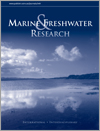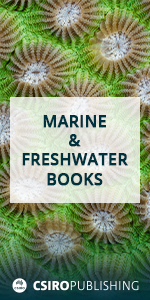Marine and Freshwater Research
Volume 72
Number 8 2021
In the past decades, the blue revolution has greatly increased the world aquaculture production. In this study, seven major socio-ecological impacts coupled with this increase were identified. So as to move towards sustainability, the following tools were also identified: technical, management, governance and legal aspects.
AUSRIVAS uses invertebrate sampling and computer models to assess the ‘biological health’ of rivers. However, it is often a weak indicator of human impact, possibly because of reliance on reference sites, inappropriate model predictors, index limitations, inconstant sampling methods and neglect of non-seasonal change. Alternative indices and the development of diagnostic methods to identify causes of impact might be preferable.
Rewilding differs from traditional restoration in its focus on a passive approach, helping humans to ‘get out of the way’, allowing nature to heal itself, often without a predefined anthropocentric outcome. This perspective explores the application of rewilding principles to rivers through holistic restoration of key functions and structures.
The absence of magnetic fields (so-called hypomagnetic field) is an unusual environment for living beings. An organism may face it in some artificial environments or during possible geomagnetic polarity reversals. The effects of hypomagnetic field on fish remain obscure. This paper showed the influence of these magnetic conditions on roach (Rutilus rutilus) embryos. Delayed consequences of R. rutilus embryos and prelarvae exposure to hypomagnetic field were also studied.
Considering salinity is a prominent environmental factor for marine fishes, the lack of comprehensive investigations of key gene families in response to various degrees of salinity stress may limit our understanding of the long-term salinity acclimation of marine fishes. In this study, the evolutionary history and function of genes in the heat shock protein 70 (Hsp70) and heat shock transcription factor (Hsf) families were investigated in Cynoglossus semilaevis, as were their regulatory mechanisms and cooperative relationship. Only hspa5 was significantly upregulated, and the expression of Hsp70 genes seemed to decrease the activity of the hsf1 and hsf2 genes.
Mustelus mustelus from the Langebaan Marine Protected Area is largely protected from fishing activities for 30 years; therefore, its biology represents those of an unfished stock. The marine protected area represents a pupping, nursery and feeding ground as well as a refuge area for the largest recorded smoothhound sharks globally, emphasising its importance in the spatial conservation of this species.
Four sexual maturity stages were recognised in male Chiloscyllium punctatum: immature (August–October), maturing (November–January) and active and resting adults (January–July). A diametric lobar type of testis was observed in C. punctatum. Different zones were detected in the testicular lobes.
The marine N cycle is driven by microorganisms whose distribution can be shaped by mesoscale eddies. We investigated the effect of a cyclonic (anti-clockwise) eddy confined in an oxygen-depleted basin on the abundance distribution of N-cycling microbial communities. Both the cyclonic circulation and the oxygen gradient shaped the distribution of nutrients and different N-cycling communities, and a potential N-loss to the atmosphere was also detected in this oxygen-depleted eddy.
Tangled lignum is an important Australian floodplain shrub. Three environmental flows were delivered to Bottle Bend Reserve, south-western New South Wales, Australia, to restore the condition of tangled lignum. This study found that tangled lignum was in a better condition at sites that received more environmental flows. Environmental flows for recovery of degraded floodplain vegetation should differ from environmental flows for maintenance of floodplain vegetation.
The present study reveals, for the first time, that rainbow trout larvae do not avoid artificial magnetic and electromagnetic fields of a magnitude observed in the vicinity of already operating underwater cables. Moreover, larvae that had been previously exposed to artificial magnetic fields were more attracted to these fields than larvae reared under natural conditions. This may constitute a potential threat for fish spawning in the vicinity of underwater cables.
The European eel is widely distributed and exploited in all European countries and North Africa. The analysis of carbon and nitrogen isotopes carried out in several Mediterranean habitats showed that this species feeds over a broad range of trophic levels and food sources. Its feeding behaviour, despite its phenotypic plasticity and extreme variability of living habitat characteristics, shows common features suggesting that, eels during their continental life generally tend to feed on prey with high nitrogen isotopes values.
Many lobsters are important urchin predators, but it is not known whether this is true of the eastern rock lobster (Sagmariasus verreauxi). An examination of the gut contents showed that S. verreauxi has a broad diet, including urchins, bivalves, gastropods and algae. Urchin hard parts occurred with moderate frequency (19%), yet this may be an underestimate of S. verreauxi feeding on urchins because feeding trials indicated that lobsters could eat urchins without ingesting spines.
We determined variations in leaf-associated biofilm components, leaf pigments and enzymatic specific activity of peroxidase among vertical segments of submerged macrophytes in a shallow lake. The results indicated that the vertical pattern of leaf physiology is closely related to light intensity, and biofilms play an auxiliary role. Vertical patterns in leaf biofilm and physiology are generally species-specific, especially in shallow areas.
Larval duration in the sea is a critical period for aquatic organisms. The migratory pattern and marine larval duration of a gobioid fish (Rhinogobius nagoyae) from rivers on Sado Island, in northern Japan, were examined. Their amphidromous life history was confirmed and marine larval duration ranged from 29 to 45 days. This short larval period may be related to environmental characteristics.





